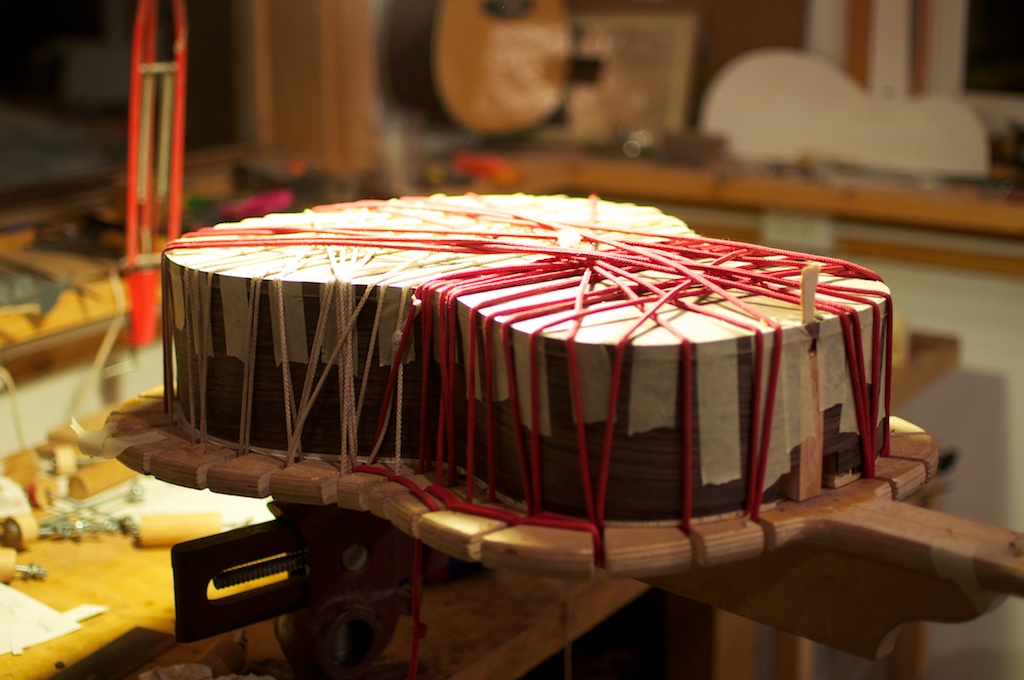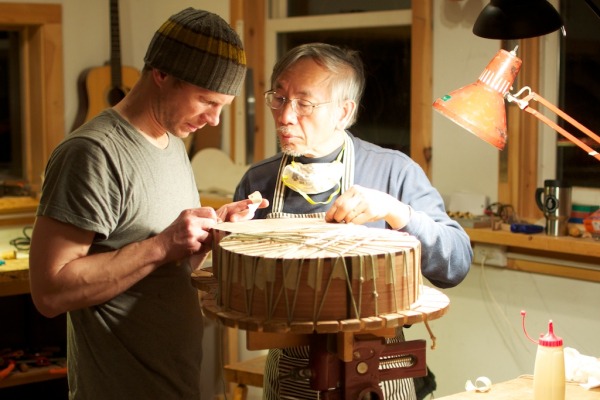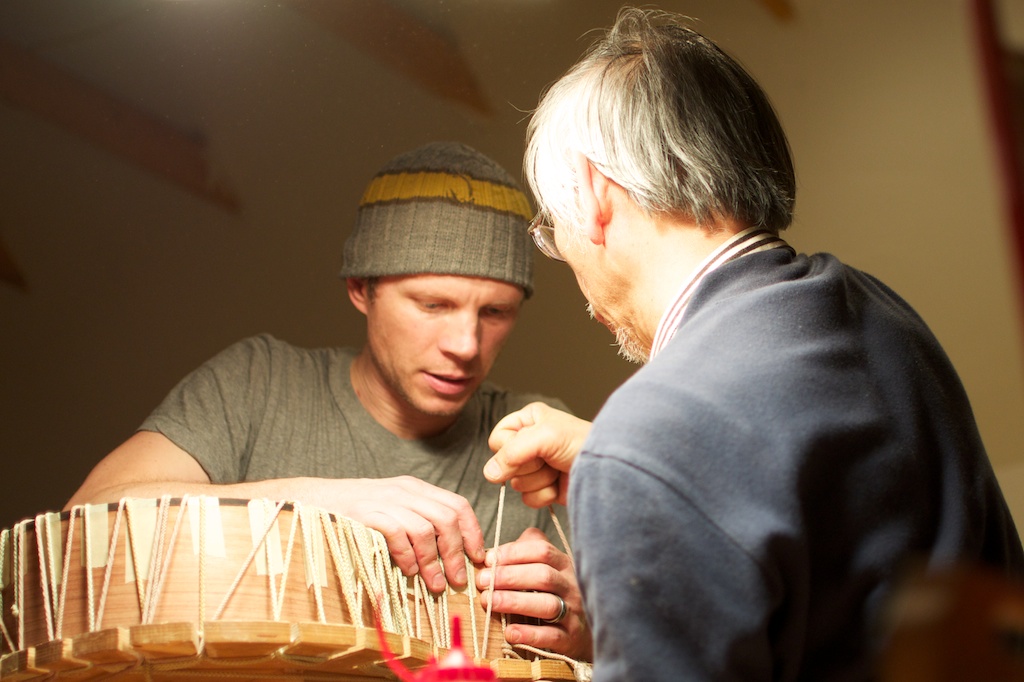Day 12 - Snow on April Fool’s Day and major catastrophe averted, just barely
Day 12: Not so many pictures today, because I was too busy troubleshooting to take many shots (and since the results of some of the work don’t look that interesting or impressive, despite our time and effort!). It was a beautiful day; we got about 4 inches of snow, but it's also warm enough that the roads look okay.
It was a long day. I went in a little early to do some minor work on my neck and truss rod that had been setting overnight, and most of the crew was already there. Once everyone arrived, and after spending some time cleaning up the body with our good friend the metal scraper, we started a task that seemingly would be easy: cutting the channel for the ebony end strip wedge and then inlaying the piece. This was surprisingly challenging for everyone, and we basically didn’t finish that up until around lunch (I had to cut my lunch short to come back and finish it up before the afternoon tasks began).
After lunch George showed us how to route the “ledge” for the binding (the dark wood edge around the top and back of the guitar. Routing the back is actually pretty tricky since it doesn’t sit perfectly perpendicular to the sides. Although I had a good handle on what and how we were suppose to do it, somehow my cut ended up being about 50% too deep, and it was dangerously close to being a structural as well as cosmetic issue. This is a BIG problem, because now my nice ebony bindings won't sit flush to the surface of the back and I've cut very deeply into my linings, which provide the connection between the back and the sides. And to make matters worse, this happened on the front too! It’s unclear if it was user error or an equipment manfunction with the router with the bit slipping down as I worked; in my defense, when George replaced the bit, the router began to behave. But at this point, it’s a bit too late. What do you do with your router cut is too deep? I figured I was screwed and would have to start my guitar over!
But George had a clever solution that in some ways even makes my guitar fancier than I had planned. He suggested making a new set of oversided bindings that had a piece of purfling attached to make them taller (purfling is a strip of veneered wood in alternating colors). In my case, I’m essentially adding a white/black/white racing stripe to my binding that will show on the side of the guitar (the other students’ guitars won’t be this fancy!). The only drawback to this solution is that now my bindings are rosewood, the same as my back/side wood, so other than the purfling, they don’t really stand out from the back/sides like the ebony would have. We didn’t have any ebony binding material big enough for the size of my oversided binding cut, so I made my own set of bindings with the orphaned rosewood side whose mate had cracked a few days earlier. I’m happy that nice piece of rosewood will make it onto the guitar! And it was interesting to be able to make bindings and glue the purfling to it (I learned to do a few things that the other students didn’t).
While this is an elegant solution to the problem, I still have some other nicks and cuts that were too deep from the router. This definitely saved the day, but my guitar will proudly display some scars from today’s mishaps. It should be noted that only one out of the five of us made it through the back binding without any problems. This is definitely a hazard stage.
Given our “issues” this afternoon, we were running late. So we took an hour for dinner and then reconvened. After dinner, George bent the new bindings I had cut (on the side bender), and I rerouted my back and top for these new “superbindings.”

The last thing to do today (to keep us on schedule) was glue the bindings onto the body. This is actually pretty time consuming, as you have to do a dry run to determine the length of the bindings so you know how much to trim off. It’s a two person job, as the body is strapped onto your board and bound with tight rope to hold the bindings in place while the glue dries. I have to give a shoutout to my classmate Matt who is a true superstar for staying late with my dad and I, even though he was done with his work for the day. We couldn’t have finished without him.


In at 7:30am, home at 11:30pm; 30 minutes for lunch, and an hour for dinner. Whew, that was a long one.
Well, I know now that my guitar won’t be cosmetically perfect. I knew that it was highly unlikely it would make it through the three weeks without any cosmetic blemishes, but until you get that first battle scar, you still hold out the hope for perfection. Now that I’ve made peace with it, I can relax a bit and enjoy the rest of the process without being so anxious.
 Friday, April 1, 2011 |
Friday, April 1, 2011 |  4 Comments | tagged
4 Comments | tagged  guitar,
guitar,  lutherie,
lutherie,  rosewood,
rosewood,  screw-up,
screw-up,  superbindings,
superbindings,  vermont instruments
vermont instruments 
Reader Comments (4)
How much do all of these construction variables affect the sound?
What a day! So glad that you and your guitar made it through! Loved the comment about being able to relax after the first battle scar...can totally relate.
@JW - The choice of good wood definitely makes a difference, with various species (e.g., rosewood, maple, etc.) having different tonal qualities. But one of the biggest factors is the way that the bracing on the top is designed and executed; see here for an example:
http://www.benjaminle.org/storage/8-top_bracing.jpg
The goal is to build a top that is light enough that it can be responsive and move freely to transmit sound, but still be strong enough to withstand all the force of strings being pulled on it (i.e., it doesn't rip off or fold in half). That's where the bracing comes in; it supports the top without restricting its movement too much. Selecting materials and creating designs that maximize the transfer of energy from the strings to the top is what it's all about.
Other important aspects of the design have to do with the adjustability of the instrument (e.g., the neck joint), and also the structural flexibility to withstand some variation in humidity (e.g., the arched back and also the binding, although those also serve largely a cosmetic function).
I'm definitely not an expert in all the aspects of guitar design, but I've learned a lot over the last two weeks!
@Abs - Yep, I almost had a meltdown....But we got things under control, and there's almost no sign of the snafu.
Relaxing after the first battle scar....Like the first time one of your kids busted a bone? :-)